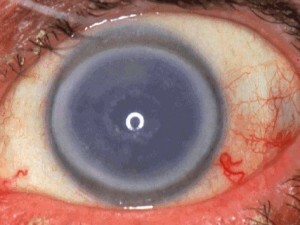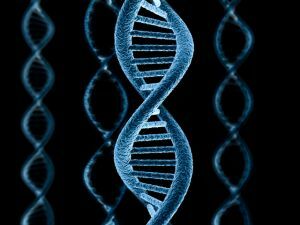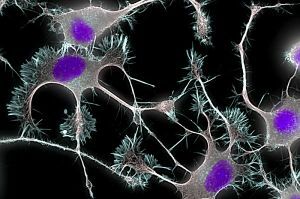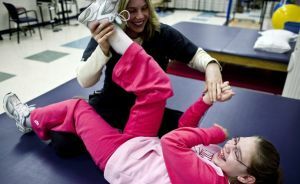 Nervous system diseases are present quite often.
Nervous system diseases are present quite often.
Basically, they show themselves neuralgia and neuritis, although there are hereditary forms of diseases. These include spinocerebellar ataxia. What is this disease?
The term "ataxia" in neurology is understood as a condition in which the consistency of conscious movements is violated.
Contents
- Gene failure
- Displays of the disorder
- Type one
- Type of the second
- Illness Machado-Joseph
- Type 5 and 6 - the safest outcome
- 7 type threatens complete blindness
- How to establish the diagnosis?
- Can this disease be cured?
- Forecast disappointing
Gene failure
This disease is hereditary and develops due to one or another genetic malfunction.
In this case, it can manifest itself in two forms - with a violation of stability and maintenance of the body in space( static-locomotor ataxia with damage to the cerebellar worm) or with damage to the hemispheres of the cerebellum and violation of the active limbs performed by the extremities( the dynamic form of cerebellar ataxia).
The disease is inherited by an autosomal dominant type. The first signs appear usually over the age of 30 years .
Quite often the clinic can develop earlier, and then it, most often, manifests itself in parallel with other neurological symptoms.
Thanks to the study of the genomic composition, it was proved that the leading role belongs to genes in the development of spinocerebellar ataxia.
It has been proved that there are at least 13 specific genes responsible for the development of ataxia, and more specifically, its specific type.
Each of these genes is located in a particular chromosome, and its damage as a result of the action of mutagens and leads to the development of the disease.
There are currently known 8 types of disorder. Spinocerebellar ataxia of 1-13 types depends on the lesion of one specific gene.
The main role belongs to increasing the number of triplets of CAG( cytosine-adenine-guanine).Normally, this sequence of nucleotides encodes the formation of glutamine - an amino acid, necessary for the formation of connections between brain proteins.
Because of the increase in its number, the protein chains are lengthened, resulting in the formation of insoluble components, which disrupt the interaction between the brain regions and kill a number of nerve cells, which contributes to the development of ataxia. 
If you consider the substance of the cerebellum, you can see that its hemispheres have undergone degenerative processes( as well as the main components involved in conducting a nerve impulse from the spinal cord to the cerebellum and back( eg, olives)).
In parallel with this, demyelination of nerve fibers is observed, which prevents the rapid spread of nerve impulses.
Manifestations of the disorder
How does the disease manifest itself?
Each of the types of ataxia is characterized by its clinical and age characteristics.
Type one
The first type of SCA develops primarily in people aged 30 to 40 years. A characteristic feature of the disease is that in the subsequent generation it can manifest much earlier than in the previous one( the so-called anticipation phenomenon).
The first symptoms of the disease are usually some awkwardness, slovenliness in the performance of fast and intense movements( for example, when running).
Over time( usually several years later), there are other symptoms - a violation of stability in the Romberg pose, dysarthria, handwriting disorder, a specific ataxic gait.
In parallel with these symptoms may develop tonic or clonic seizures, increase tendon or the appearance of pathological reflexes.
In later stages of the disease, there may be dementia, a fade disorder, a disorder of the pelvic organs.
 Polyradiculoneuritis is an acutely developing disease of the peripheral nervous system, which is most often caused by an infection. Details in the article.
Polyradiculoneuritis is an acutely developing disease of the peripheral nervous system, which is most often caused by an infection. Details in the article. Severe disease leptospirosis in humans is difficult to cure. Preventive measures of prevention, which will avoid disease.
The type of the second
of the second type of SCA proceeds almost as well as the first type of ataxia.
The characteristic features of the disease is the development of slower saccades( coordinated movements of eyeballs), as well as a pronounced anticipation, especially in the male line.
Disease Machado-Joseph
Machado-Joseph disease( spinal-carbellar ataxia of type 3) has a rather pronounced polymorphism of symptoms.
The disease, in addition to cerebellar lesions, can also occur with a clinic of extrapyramidal disorders( such as parkinsonism or dystonia), amyotrophy and pyramidal tract damage.
Specific for ACS 3 symptoms are ophthalmoplegia, phenomenon of "bulging eyes" , twitching of the eye contiguities of ACS 4, in addition to the main disorders occurs with symptoms of sensory neuropathy.
Type 5 and 6 are the safest outcome of
Spinocerebellar ataxia of types 5 and 6 are relatively favorable.
They develop at a much later age, and clinical manifestations are not very pronounced, which allows patients to stay in society for a long time.
type 7 threatens complete blindness.
Type 7 ataxia occurs, usually with retinal damage, with its complete detachment and development of blindness. Visual impairment, often, is a harbinger of symptoms and can significantly outpace coordination disorders.
of CCA 8 - SCA 13 are currently poorly studied, as they are extremely rare.
How to establish a diagnosis?
Preference is given to imaging techniques, such as computer or magnetic resonance imaging.
 They allow to determine areas of degeneration of nerve fibers, demyelination of neurons in the bridge, expansion of all components of the cerebrospinal fluid circulation system, atrophic changes in the cortex of the cerebral hemispheres.
They allow to determine areas of degeneration of nerve fibers, demyelination of neurons in the bridge, expansion of all components of the cerebrospinal fluid circulation system, atrophic changes in the cortex of the cerebral hemispheres.
Some other diseases that occur with a similar clinic( such as tumors of the posterior cranial fossa, multiple sclerosis, hydrocephalus, cerebral vascular pathology, especially in the vertebral-basilar department) should also be excluded for the diagnosis, if
is confirmed on the basis of the clinicataxia, it is much more difficult to determine the type of disease( if there are no strictly specific symptoms).
Genodiagnostics is recommended for those individuals who have had a family history of the disease
It is best to conduct a prenatal study to determine the treatment strategy in the future
Can this disease be cured
Currently, there are several opinions on the tactics of treating this pathology.
Supporters of the first opinion are of the opinion that ataxia is not susceptible to drug treatment.
In this case, it is best to maintain maintenance therapy, which helps slow the progression of the disease. The mandatory complex includes exercise therapy( vestibular training), as well as many methods of social, domestic and labor rehabilitation.
Another theory suggests the use of certain drugs, however, treatment is purely symptomatic or stimulating. 
Vitamin injections are prescribed, as well as their oral intake. As an element of such therapy, it is possible to prescribe anticonvulsants( according to indications).
Treatment of spinocerebellar ataxia is also supported by certain physiotherapeutic procedures( for example, electrostimulation).
Forecast disappointing
As for the prognosis of the disease, patients with ataxia live on average about 15 - 20 years. With proper care, as well as a timely diagnosed disease and the use of maintenance therapy, it is possible to extend life by 7-10 years.
Patients with ataxia of 5 or 6 types can live normally somewhat longer( life span usually does not change much).
Given that the disease is poorly treated, it is necessary to improve the available methods of diagnosis, as well as to try and discover and implement new treatment tactics.



